Literature
Romeo and Juliet by William Shakespeare describes atomies pulling Queen Mab's carriage.
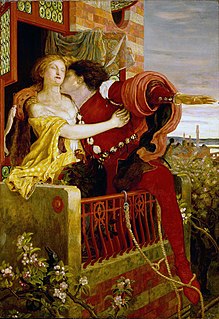
Romeo and Juliet is a tragedy written by William Shakespeare early in his career about two young star-crossed lovers whose deaths ultimately reconcile their feuding families. It was among Shakespeare's most popular plays during his lifetime and along with Hamlet, is one of his most frequently performed plays. Today, the title characters are regarded as archetypal young lovers.
Queen Mab is a fairy referred to in William Shakespeare's play Romeo and Juliet, where "she is the fairies' midwife." In the play, she is a symbol for freedom and also becomes Romeo's psyche after he realizes that he is also a floating spirit. Later, she appears in other poetry and literature, and in various guises in drama and cinema. In the play, her activity is described in a famous speech by Mercutio written originally in prose and often adapted into iambic pentameter, in which she is described as a miniature creature who performs midnight pranks upon sleepers. Being driven by a team of atomies, she rides her chariot over their noses and "delivers the fancies of sleeping men." She is also described as a midwife to help sleepers "give birth" to their dreams. She may be a figure borrowed from folklore, and though she is often associated with the Irish Medb in popular culture, and has been suggested by historian Thomas Keightley to be from Habundia, a more likely origin for her name would be from Mabel and the Middle English derivative "Mabily" all from the Latin amabilis ("lovable").
O, then, I see Queen Mab hath been with you.
She is the fairies’ midwife, and she comes
In shape no bigger than an agate-stone
On the fore-finger of an alderman,
Drawn with a team of little atomies
Athwart men’s noses as they lie asleep;
Her wagon-spokes made of long spinners’ legs,
Fairy-Land by Edgar Allan Poe references atomies in the last lines:
They use that moon no more
For the same end as before-
Videlicet, a tent-
Which I think extravagant:
Its atomies, however,
Into a shower dissever,
Of which those butterflies
Of Earth, who seek the skies,
And so come down again,
(Never-contented things!)
Have brought a specimen
Upon their quivering wings.
This page is based on this
Wikipedia article Text is available under the
CC BY-SA 4.0 license; additional terms may apply.
Images, videos and audio are available under their respective licenses.

Oberon is a king of the fairies in medieval and Renaissance literature. He is best known as a character in William Shakespeare's play A Midsummer Night's Dream, in which he is Consort to Titania, Queen of the Fairies.
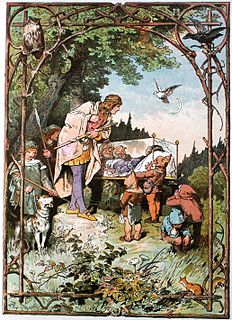
"Snow White" is a 19th-century German fairy tale which is today known widely across the Western world. The Brothers Grimm published it in 1812 in the first edition of their collection Grimms' Fairy Tales. It was titled in German: Sneewittchen and numbered as Tale 53. The name Sneewittchen was Low German and in the first version it was translated with Schneeweißchen. The Grimms completed their final revision of the story in 1854.

Mab, or Uranus XXVI (26), is an inner satellite of Uranus. It was discovered by Mark R. Showalter and Jack J. Lissauer in 2003 using the Hubble Space Telescope. It was named after Queen Mab, a fairy queen from English folklore who is mentioned in William Shakespeare's play Romeo and Juliet.
Fairyland, in English and Anglo-Scottish folklore, is the fabulous land or abode of fairies or fays. Old French faierie referred to an illusion, or enchantment; the land of the Faes. Modern English fairy transferred the name of the realm of the fays to its inhabitants, e.g. the expression fairie knight in Spenser refers to a "supernatural knight" or a "knight of Faerie" but was later re-interpreted as referring to a knight who is "a fairy".

Merlin is a 1998 television miniseries which originally aired on NBC that retells the legend of King Arthur from the perspective of the wizard Merlin.
The Fairy Queen, in English folklore, traditionally ruled the fairies. "Fairy Queen" may alternatively refer to:

Little Things is an original novel based on the U.S. television series Buffy the Vampire Slayer.
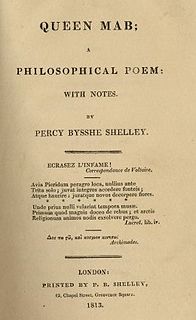
Queen Mab; A Philosophical Poem; With Notes, published in 1813 in nine cantos with seventeen notes, is the first large poetic work written by Percy Bysshe Shelley (1792–1822), the English Romantic poet. After substantial reworking, a revised edition of a portion of the text was published in 1816 under the title The Daemon of the World.
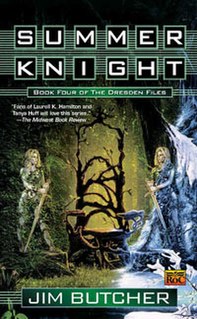
Summer Knight is a 2002 New York Times Bestselling contemporary fantasy novel by author Jim Butcher. It is the fourth novel in The Dresden Files, which follows the character of Harry Dresden, present-day Chicago's only professional wizard.

God save the Queen is a 96-page graphic novella published in 2007 by Vertigo DC Comics. It was written by Mike Carey and painted by John Bolton.

Tylwyth Teg is the most usual term in Wales for the mythological creatures corresponding to the fairy folk of English and Continental folklore and the Irish Aos Sí. Other names for them include Bendith y Mamau, Gwyllion and Ellyllon.

In folklore, fairy-locks are the result of fairies tangling and knotting the hairs of the sleeping children as they play in and out of their hair at night.
Queen Mab usually refers to:
Queen of Elphame or "Elf-hame", in the folklore belief of Lowland Scotland and Northern England, designates the elfin queen of Faerie, mentioned in Scottish witch trials. She is equivalent to the Queen of Fairy who rules Faërie or Fairyland. The Queen, according to testimony, has a husband named "Christsonday".
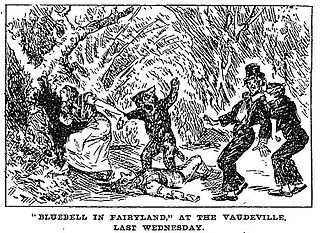
Bluebell in Fairyland is a Christmas-season children's entertainment described as "a musical dream play", in two acts, with a book by Seymour Hicks, lyrics by Aubrey Hopwood and Charles H. Taylor, and music by Walter Slaughter. It was produced by Charles Frohman. The creators sought to distinguish the work from a Christmas pantomime. The story concerns a flower girl, Bluebell, who on Christmas Eve goes to fairyland in search of the "Sleeping King", seeking to restore him to his throne, which has been usurped by the "Reigning King".

The Fairy Queen or Queen of the Fairies is a figure from Irish and British folklore, believed to rule the fairies. Based on Shakespeare's influence, in English-speaking cultures she is often named Titania or Mab.

Hellboy: The Wild Hunt is the ninth collected edition in Mike Mignola's Hellboy comic book series, the second of three connected story arcs written by Mignola and illustrated by Duncan Fegredo. Its eight chapters, collected in March 2010, were originally released from December 2008 through November 2009 as issues 1-8 of the Hellboy: The Wild Hunt limited series, also numbered as issues 37 through 44 of the continuing Hellboy series. The storyline delves into Irish and Arthurian legend, reprising several characters first introduced in Hellboy short story "The Corpse". As with Hellboy stories generally, it was published by Dark Horse Comics.
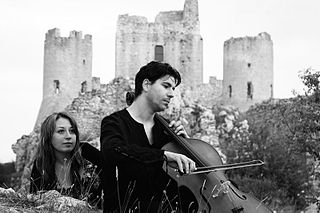
Hexperos is an Italian duo founded in 2004 by Alessandra Santovito and Francesco Forgione.

The Pirate Fairy is a 2014 American 3D computer-animated fantasy film directed by Peggy Holmes. It is the fifth direct-to-video feature-length animated film in the DisneyToon Studios' Tinker Bell film series and the Disney Fairies franchise, based on the character Tinker Bell from J. M. Barrie's Peter and Wendy. The film features the voices of Mae Whitman, reprising her role of Tinker Bell, Christina Hendricks as a dust-keeper fairy named Zarina, and Tom Hiddleston as a much younger James Hook.
















